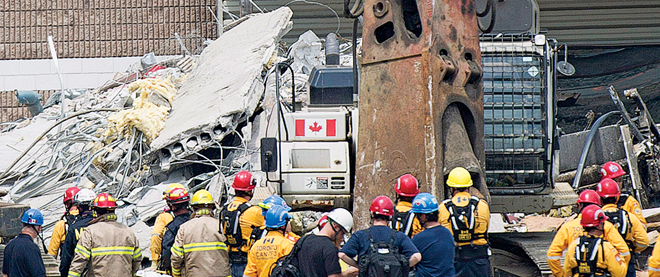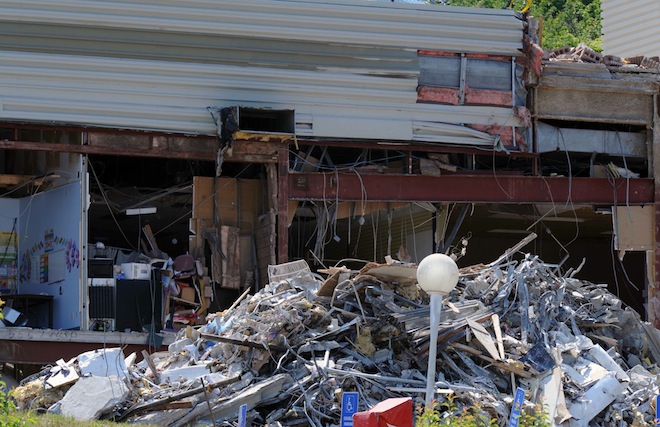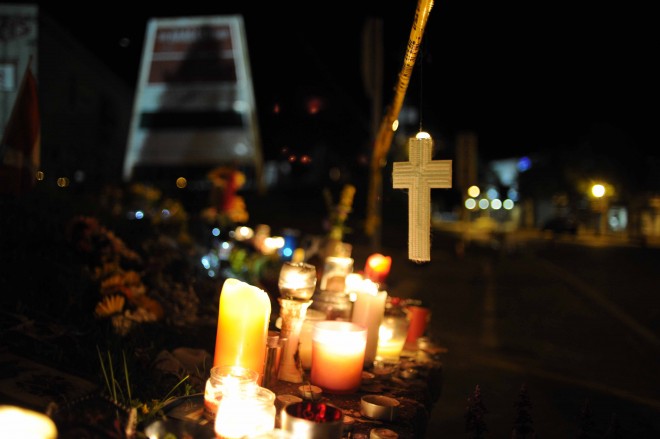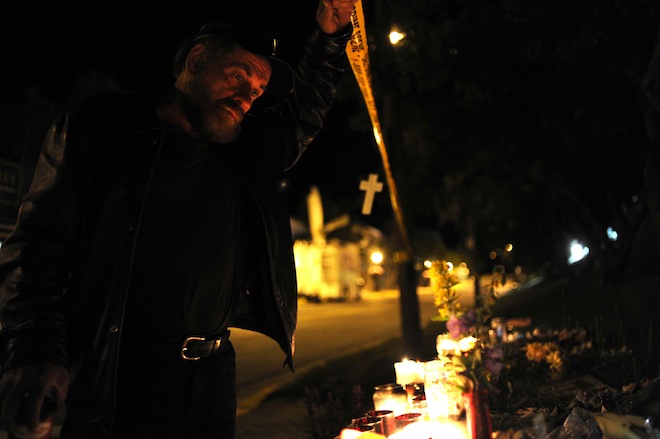Elliot Lake: The first rescuers inside the mall share their harrowing account
Plus, what the tragedy in Elliot Lake says about our country’s readiness to deal with catastrophes
Share

In places like Elliot Lake (population 11,300), the locals like to say that everyone knows everyone. It’s not true, of course. Even the smallest of towns have strangers. But in this pocket of northern Ontario—where Lucie Aylwin was proudly born and raised—it’s hard to find someone who didn’t know her. An employment counsellor stationed at the Algo Centre Mall, the 37-year-old helped countless residents fine-tune their resumés and land a job. “She would help anybody,” says her fiancé, Gary Gendron. “If she wasn’t capable of doing it, she would find a way of doing it. She would never give up.”
On that Saturday afternoon, June 23, Aylwin was at work—not in her usual office, but at the lottery kiosk on the mall’s second floor, right across from the food court. With a wedding to plan, she took the weekend job to help pay the bills. “We had breakfast together,” Gendron recalls. “She gave me another big hug and a kiss and said: ‘I’ll see you at 6:30.’ ”
It was a few minutes past 2 o’clock when Doloris Perizzolo walked toward the lottery counter. The 74-year-old widow was a food-court regular, another familiar face among so many. Just days earlier, Perizzolo had won $1,000 on a “Money Multiplier” scratch ticket. She was back again to test her luck.
At a table nearby, John Marceau was sitting with three friends and a hot cup of coffee (one cream, one sugar) from Mum’s Place. “I didn’t even have time to drink nothing out of it,” says the 79-year-old. “Right in front of me, a big cement beam fell down. I was thrown about eight feet.” Jean-Marc Hayward was halfway through his own coffee when the room started to shake. “I heard a loud noise that got louder and louder,” he recalls. “I looked left and part of the roof came down. It seemed like it happened in slow motion.”
It didn’t. Before anyone could even react, a giant slab of concrete—12 m by 24 m—plummeted from the parking lot above, smashed into the lottery kiosk, and sliced through the second floor. “It felt like an earthquake,” says Josh Marshall, another shopper who narrowly survived. “Like someone smacked you in the ears.”
The first 911 call came in at 2:19 p.m.
Capt. John Thomas, a 16-year veteran of the Elliot Lake Fire Department, was among the initial rescue workers to rush inside. Red helmet on his head, an oxygen tank on his back, Thomas ran up a set of exterior stairs to what was left of the second floor. Looking up from the food court, he could see the sun shining through the roof. Down below, on the main level, was a pile of cement and other debris nearly 10 feet high. A silver Ford Explorer was among the rubble. “It was like a dream,” he says now. “But we had a job to do, and I went in mode.”
They pounced on the rubble—police, medics, firefighters (full-time and volunteer)—scouring for survivors. Is anybody here? Tell us where you are. It was Thomas who first heard the voice. “It was like a mumble, and it was really hard to distinguish the direction,” says Capt. Darren Connors, another firefighter who climbed the pile. “I was looking down a small triangular hole, trying to stuff my head in. The adrenalin is running through you so hard that you think you can move all that concrete—and you do your damndest to try.”
At one point, the team did manage to pick up a table-sized piece of cement, convinced that the voice was directly underneath. All they found was more debris.
The crew had no idea at the time, but the voice belonged to Lucie Aylwin. Amazingly, she had survived the collapse. Her customer, though, was not so fortunate. One of the firefighters found Doloris Perizzolo near the top of the pile, covered in concrete. Only a hand and a foot were visible. “I slid her watch up and tried to feel if I could get a pulse,” Thomas recalls. “She was cold to the touch.”
The men focused their attention back on the voice, moving anything that was light enough to lift. Bricks. Railings. Benches. Flowerpots. Using a sewer camera from the city’s public works department, firefighter Adam Vance tried to pinpoint their survivor. “I stuck that camera down every hole we could find,” he says. “There are pieces of rock falling, and you can hear little chunks of concrete hit and tang off some pipes. Things are moving and shifting, but we just kept going.”
Metal beams and cement slabs dangled from the roof. “Widow-makers,” as rescue workers call them. The second-floor escalator—the one that used to go up from the lottery kiosk to the roof parking lot—was still in place, but it was covered in chunks of concrete. Like a slide to a swimming pool, that escalator hovered over the pile, threatening to let go at any moment.
Paul Officer, Elliot Lake’s fire chief, was left with a painful decision. “We had to pull back,” he says. “There was absolutely nothing else we could have done. All we were doing at that point was risking lives.” He watched with pride as Thomas tried to move one last slab, to no avail.
“There was somebody there,” Thomas says, tearing up at the memory. “I could have kept digging. I could have tried harder. I failed.”
He didn’t fail. None of those men did. They sprinted into a disaster zone hoping to save lives, oblivious to the danger. Unfortunately, bravery alone is not enough to lift thousands of pounds of concrete. Their only choice was to wait for specially trained reinforcements: a team from the Toronto-based HUSAR (Heavy Urban Search and Rescue). “None of us wanted to leave; that is not our job,” Vance says. “It was heartbreaking.”
In the months to come, a public inquiry will examine exactly what happened at the Algo Mall and, although the courage of those first responders was never in doubt, so many other questions linger. The building itself was such a leaky, saggy mess—tarps in the ceiling, buckets on the floor—that tragedy seemed to be a matter of when, not if. This week, police launched a criminal investigation into the roof collapse.
For Canadians who watched the drama unfold on television, what happened in Elliot Lake raises much larger questions about the state of our country’s emergency preparedness. From a distance, the rescue mission that unfolded over the next four days was itself an utter disaster, beset by miscommunication, misjudgment, and even accusations of cowardice. Did the HUSAR team have the proper equipment? Did they underestimate just how rickety the building was? Why, after the search was abruptly halted, did it seem to take a phone call from Ontario Premier Dalton McGuinty to put the mission back on track? And why wasn’t that massive robotic crane—the tool that finally did the trick—not dispatched north in the first place?
The public, and the grieving families, deserve a thorough explanation. But as the inquiry will discover, those answers are never as simple as they seem. The men who came to Elliot Lake to search for survivors were as devastated as anyone that nobody came out alive. Their plan of attack was working right up until the final moments, when that teetering escalator forced them to flee.
Should their original plan have been different? The public inquiry will examine that question, and many more. But if anything, the process will also challenge our most basic assumptions about the people who are trained to respond to such catastrophes.
How much risk do we expect them to take? How many lives should be jeopardized in the hope, however faint, of saving one?
Bill Neadles was doing some afternoon gardening when his cellphone rang, just two hours after the mall collapsed. A staff inspector with the Toronto police, the 56-year-old is also one of the commanders of the city’s HUSAR unit, a joint municipal-provincial-federal task force of cops, medics, firefighters, engineers and doctors who are specially trained to fish people out of toppled buildings. (There are five such teams in Canada and, although it’s often reported otherwise, they existed before 9/11.)
June was Neadles’s month to be on call, so when the request from Elliot Lake reached the provincial fire marshal’s office, he was the point man. He left his lawn mower in the middle of the backyard and drove to the unit’s rendezvous point.
At that moment, his team officially belonged to the Ontario government.
By 9 p.m., 37 members of the HUSAR squad were barrelling along the highway, a convoy of vans, a bus and a row of tractor-trailers carrying everything from industrial power saws to skids of lumber. Anything they might need to slice open concrete or shore up a ceiling. On the ride north, Neadles and his crew pored over blueprints of the mall and examined some of the early photos hitting the news. But it wasn’t until 4:25 Sunday morning, when the team rolled into the parking lot, that they fully grasped the damage. “This was a magnitude way beyond what we’d ever seen,” says Michael McCallion, a senior Toronto medic and Neadles’s second-in-command. “We knew that it was going to take us a long time to get to any of the victims, and it was going to have to be slow and methodical.”
When people think of search and rescue, slow and methodical are not the words that spring to mind. They think of blind courage. Split-second reaction. Firefighters running into the Twin Towers. Chris Rowland understands that better than most. A Toronto firefighter and a HUSAR member, he wears both hats: the first responder, and the second. “We push that all the time: we are no longer first responders when we show up,” he says. “Everything is slow and under control. Everything we do is calculated. It has to be.” For the safety of the victims—and the rescue workers trying to reach them.
Neadles split his team into two shifts and the reconnaissance began. The main entrance to the mall—the one right underneath that dangling escalator—was deemed off-limits. Instead, the team entered through a first-floor service door on the other side of the building. Yet even then, just to reach the rubble pile, the crew had to secure what was left of the first-floor ceiling—the chunk that didn’t come down with the lottery kiosk. At that point, they essentially became a construction crew, hammering together large wooden support posts to hold up the roof.
Lucie Aylwin was literally steps away, buried somewhere in that pile. But to reach her, the path had to be secure. “People don’t understand this: they’re actually working in a crumble zone,” McCallion says. “At any time, this stuff could all come down on us.”
At 9:30 a.m.—more than 19 hours after the collapse—they heard the tapping.
“We looked at each other and said: ‘Okay, did we really hear that?’ ” says Sgt. Jim Lawson. “We called for silence and we could hear a distinctive tap.” Lawson yelled toward the pile, asking for another one. He got it. “You get that rush: ‘Let’s go, let’s go!’ Then you get the realization that you can’t get in there.” Not yet, at least. It took almost three more hours just to find a relatively safe route for Ranger, the team’s German shepherd, who is trained to sniff out signs of life. “I stood back from a distance and sent him in,” says his handler, Sgt. Scott Fowlds. “He climbed up to the top of the pile and he’s working it, circling around an area, sticking his head inside a void. Then he started barking.” Whoever was tapping was still alive.
The plan—though frustratingly slow to people watching from the road—appeared to be on track. Crews continued to stabilize the ceiling near the rear entrance, while local police and firefighters carted out some of the debris leading to the pile. “We’re like tunnel rats,” Neadles says. “But you don’t know what is connected to what. You could pull out a small piece of concrete, it creates a void, and boom, the whole thing comes down.”
Outside, a large crane worked overhead, hauling out some of the larger pieces of rubble through the hole in the roof. As Sunday night turned into Monday morning, the crane lowered down something else: an Ontario Provincial Police officer, equipped with an electronic device that works a lot like Ranger’s nose. “It shows a black square for movement and red circles for breathing,” Vance says. “He’s down there and he says: ‘Holy s–t, guys.’ There was a big red dot in the middle.” Lucie Aylwin was still breathing.
It was 4 o’clock Monday morning. Nearly 38 hours had passed since the roof caved in.
As the sun rose that morning, the team continued to tunnel its way toward their one confirmed survivor. There was still hope.
But as they cut and cleared, inch by agonizing inch, the escalator above had other plans. The metal beams holding it in place (one on the bottom, one on the top) were slowly buckling, severely overstressed by the concrete slabs resting on top. Again, the bottom of the escalator was pointing directly into the rubble pile, on the opposite side of where the men were approaching. If it fell, everyone underneath, including Aylwin, would be crushed.
Structural engineers working for HUSAR and the provincial ministry of labour conducted frantic calculations, but each time the answer was the same: the escalator, and the staircase beside it, were certain to fail. At 3 p.m., Neadles ordered everyone out.
“It weighs very heavily on me to have to turn around and leave that individual in a position so helpless and defenceless,” he says. “But that’s a decision I had to make, and I will tell you very straight-up: I would make it again today, tomorrow and next week. I just couldn’t put those men in a perilous position of that escalator coming down.”
When Neadles broke the news to his men, some volunteered to go back inside anyway. “They had tears in their eyes,” McCallion says. “We had a lot of guys say: ‘Screw it. We’ll do it. Don’t worry about it.’ But how would the spin on this be different if we had stayed in and it collapsed, and now we’re talking about three dead rescuers?”
Even the locals, who lined the street praying for a miracle, may have understood that logic. But what they couldn’t understand were the words that came out of Bill Neadles’s mouth. At a 5 o’clock press conference—just 13 hours after an officer detected signs of life—Neadles told reporters that his team had reached its “end,” and it was now up to the mall’s owner to hire a demolition crew to remove the “two bodies.” Paul Officer, the fire chief, was sitting beside Neadles at the conference. “If you look at me in those tapes, I’m not overly happy,” he says. “Obviously, it wasn’t an acceptable solution.”
Outside the mall, Elliot Lakers were furious. Chanting protesters, many of them former miners, threatened to storm the site and continue the search themselves. Aylwin’s fiancé was sobbing. “I want her out of there, and they’re giving up,” he said. “They can’t f—ing give up.”
Local officials had no intention of doing that. The fire chief, the mayor and other senior staff met behind closed doors to consider the next step—without Neadles. “I wasn’t upset with Bill,” Officer says. “I knew he had reached the end of what he could do with his team, no different than I did with my team at the start. I was more upset with the fact that this can’t be.”
Technically—and this will certainly be a focus of the public inquiry—Neadles did not have any authority once engineers declared the mall unsafe. The scene was now in the hands of local officials and the Ministry of Labour. But he was the province’s point man on the ground for the rescue operation, and before he had a chance to speak to his superiors, he essentially told the country that his guys were packing up and heading home.
“I sure wish I had chosen my words a little bit differently,” Neadles admits now. “We weren’t going anywhere. The word ‘ended’ was misused by me. Our function at that point in time had ended, but there are other functions for us to do. And that’s where we needed to get the authority to do more.”
That authority came from Dan Hefkey, a former police officer who is now Ontario’s commissioner of community safety. The two had a phone conversation shortly after the press conference, and Neadles suggested the idea that would eventually come to fruition: a custom-made robotic crane, from Priestly Demolition near Toronto, that could reach through the roof and dismantle the escalator. One of Neadles’s crew members had already reached out to the company to see if the equipment was available. “Bill was saying: ‘Dan, do I have permission to go beyond my mandate and seek out these things?’ ” Hefkey says. “That’s what happened. We were already talking about options.”
By then, though, the damage was done. People outside the mall were jeering at the search-and-rescue team, including local firefighters. Cowards. You should all be fired. “One lady told me: ‘You guys come and you don’t care,’ ” says Fowlds, the dog handler. “I took my sunglasses off and I told her: ‘Look in my eyes.’ I was crying.” By 8 p.m., the outrage had reached such a pitch that Premier McGuinty wanted to personally speak to Hefkey and Neadles.
“He said we have to do everything we can to help these families and help these two people,” Neadles says. “Mr. Hefkey and I put it forward that we had a plan that we’d been roughing out, and the premier said: ‘By all means, continue.’ There was no direction. It was just: ‘Put your plan together.’ ”
Local officials were still meeting, tossing out potential solutions, when Neadles walked in and announced Plan B. “It was jubilation, giving you that extra energy again,” Officer recalls. “Bill is not a quitter, by any means.”
That night, McGuinty’s office issued a press release, saying the premier had “instructed” the rescue crews “to leave no stone unturned.” The inference was clear: McGuinty personally ordered the crew back inside the danger zone. But in the days to come, he went out of his way to clarify the confusion. “I think it’s very important to have this on the record,” he said. “They never quit . . . They wanted to do what I began to urge them to do.”
A crowd of hundreds broke into applause as the Priestly crane, with its giant lobster claw, rolled toward the mall. It was Tuesday night, a few minutes before 9 p.m.—a full 28 hours since Bill Neadles’s press conference.
Operators worked through the night, ripping apart the exterior wall until the shears could finally grab that escalator. (The original Plan B, to reach through the roof, proved impossible.) By early Wednesday morning, the HUSAR team was back inside, carving its final steps toward the victims.
Doloris Perizzolo was removed first, carried out in a yellow gurney. Lucie Aylwin—who managed to survive for so long—could not hang on long enough. She was buried for more than 90 hours.
If that robotic crane was ordered on day one, would Aylwin still be alive? The answer seems obvious, even to McGuinty. “Maybe one of the lessons that we can draw together from this is that in the future we need to make sure that we have heavy equipment standing by, just in case the usual process for extracting people who are caught up in rubble doesn’t pay dividends,” the premier conceded.
Hindsight, of course, is a wonderful thing. “We were less than 10 feet away from those two victims,” Neadles says. “We were confident we were going to reach them and be able to do what we needed to do through our normal means of operation. So at that point, I wasn’t thinking of heavy equipment.”
Maybe next time he will. Maybe next time that Priestly crane will be standard operating procedure. Maybe next time the escalator won’t loom like the sword of Damocles.
And maybe next time, despite our romantic preconceptions, Canadians will understand what HUSAR really does. “Everybody can armchair-quarterback this thing, and that’s human nature,” McCallion says. “We have a saying: ‘If we do an exercise and we come out, it’s a good day. If we can go down and bring somebody out alive, it’s a great day.’ We know there are people injured, but we have to be safe.”
Back at the Elliot Lake fire hall, the men who sprinted up the pile have learned their own difficult lessons. “I’m not so tough,” Thomas says. “I couldn’t make things any better. It’s an awful feeling to be helpless.”
Additional photos by photographer Cole Garside:




